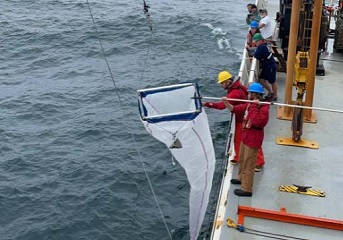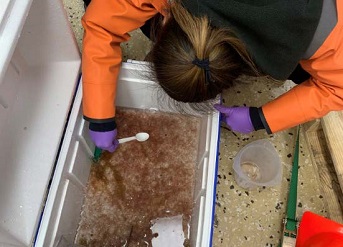Bight partnerships to expand understanding of acidification


The Southern California Bight Regional Monitoring Program is partnering with three other West Coast marine monitoring groups this summer to produce the most comprehensive picture to date of how ocean acidification (OA) is changing coastal seawater chemistry and how vulnerable marine organisms are being affected.
The paired chemistry and biology data sets – which will eventually span eight sampling quarters – will offer unprecedented insights into the pace at which OA conditions are changing in the Southern California Bight, as well as enable researchers to directly compare Bight OA changes to West Coast-wide trends.
The coordinated sampling effort, which kicked off in July, is the product of a joint partnership between the SCCWRP-facilitated Bight program and the National Oceanic and Atmospheric Administration (NOAA), California Cooperative Fisheries Investigations (CalCOFI) and Applied California Current Ecosystem Studies (ACCESS) Program. Before the partnership, the programs sampled OA chemistry data only at various specific locations along the West Coast, and had never coordinated to produce both comparable OA chemistry and biology data.
OA researchers and managers have long cited improved coordination among West Coast OA monitoring programs as a key goal to work toward. In 2016, the West Coast Ocean Acidification and Hypoxia Science Panel – which included two SCCWRP scientists – recommended, among other things, that West Coast monitoring programs work together to generate more spatially and temporally rich data sets on OA’s West Coast trajectory.
Robust OA data sets are foundational to improving understanding of which marine habitats will be disproportionately affected by OA and which actions managers should take to mitigate and offset OA’s intensifying effects.
The four-way partnership, which was forged over the past year, was largely a fortuitous consequence of delays caused by the COVID-19 pandemic. Originally, the OA element of Bight ’18 had planned to coordinate with NOAA’s West Coast Ocean Acidification Survey only. But as a result of a year-long interruption in the planned sampling effort, SCCWRP and the Bight program had additional time to coordinate and plan with CalCOFI and ACCESS.
The end result is that all four groups are coordinating their OA chemistry sampling efforts, and all four groups are adding OA biology sampling to their programs. Additionally, the Bight program and CalCOFI are leveraging their OA biology sampling effort to also explore how to use the DNA that organisms have shed into their environment – known as environmental DNA, or eDNA – as a potential alternative for monitoring vulnerable marine communities.
Traditional OA biology sampling involves collecting certain sentinel organisms – including tiny sea snails known as pteropods – that are sensitive to changing seawater chemistry, then analyzing them under a microscope for signs of impairment to growth and development. Bight ’18 test-drove and validated pteropod collection and analysis methods during an initial 2019-2020 sampling event, just prior to the start of the pandemic.
This biological monitoring will be coupled with OA chemistry sampling, which involves taking measurements of multiple chemical properties of seawater at various depths, including pH, carbonate saturation and conductivity.
When researchers couple OA chemistry and biology data that have been collected in tandem, they’re able to improve understanding of how changing seawater chemistry conditions manifest as adverse biological effects in vulnerable marine organisms. These insights are particularly important as researchers work to model and predict how West Coast OA conditions will change over time.
For more information, contact Dr. Karen McLaughlin.
More news related to: Bioassessment, Climate Change, DNA Barcoding, Ocean Acidification and Hypoxia, Regional Monitoring, Southern California Bight Regional Monitoring Program, Top News